
Horse breeding is reproduction in horses, and particularly the human-directed process of selective breeding of animals, particularly purebred horses of a given breed. Planned matings can be used to produce specifically desired characteristics in domesticated horses. Furthermore, modern breeding management and technologies can increase the rate of conception, a healthy pregnancy, and successful foaling.
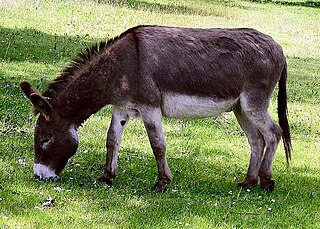
The donkey or ass is a domestic animal in the horse family. It derives from the African wild ass, Equus africanus, and has been used as a working animal for at least 5000 years. There are more than 40 million donkeys in the world, mostly in underdeveloped countries, where they are used principally as draught or pack animals. Working donkeys are often associated with those living at or below subsistence levels. Small numbers of donkeys are kept for breeding or as pets in developed countries.
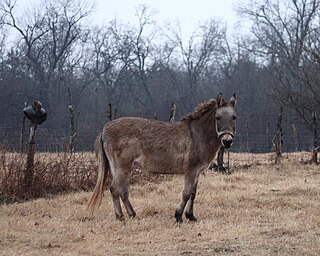
A hinny is a domestic equine hybrid that is the offspring of a male horse and a female donkey. It is the reciprocal cross to the more common mule, which is the product of a male donkey and a female horse. The hinny is distinctive from the mule both in physiology and temperament as a consequence of genomic imprinting.

The Percheron is a breed of draft horse that originated in the Huisne river valley in western France, part of the former Perche province from which the breed takes its name. Usually gray or black in color, Percherons are well muscled, and known for their intelligence and willingness to work. Although their exact origins are unknown, the ancestors of the breed were present in the valley by the 17th century. They were originally bred for use as war horses. Over time, they began to be used for pulling stagecoaches and later for agriculture and hauling heavy goods. In the late 18th and early 19th centuries, Arabian blood was added to the breed. Exports of Percherons from France to the United States and other countries rose exponentially in the late 19th century, and the first purely Percheron stud book was created in France in 1883.
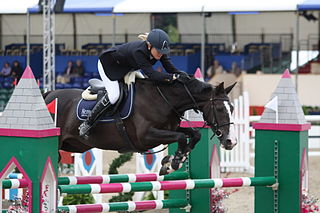
The Selle Français (SF) is a breed of sport horse from France. It is renowned primarily for its success in show jumping, but many have also been successful in dressage and eventing. An athletic horse with good gaits, it is usually bay or chestnut in color. The Selle Français was created in 1958 when several French riding horse breeds were merged into one stud book. The new breed was meant to serve as a unified sport horse during a period when horses were being replaced by mechanization and were transforming into an animal used mainly for sport and leisure.
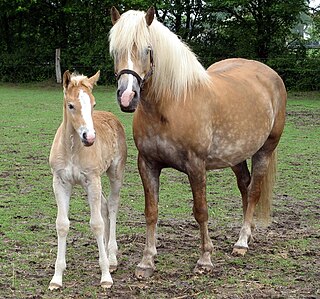
The Haflinger, also known as the Avelignese, is a breed of horse developed in Austria and northern Italy during the late 19th century. Haflinger horses are relatively small, are always chestnut with flaxen mane and tail, have distinctive gaits described as energetic but smooth, and are well-muscled yet elegant. The breed traces its ancestry to the Middle Ages; several theories for its origin exist. Haflingers, developed for use in mountainous terrain, are known for their hardiness. Their current conformation and appearance are the result of infusions of bloodlines from Arabian and various European breeds into the original native Tyrolean ponies. The foundation sire, 249 Folie, was born in 1874; by 1904, the first breeders' cooperative was formed. All Haflingers can trace their lineage back to Folie through one of seven bloodlines. World Wars I and II, as well as the Great Depression, had a detrimental effect on the breed, and lower-quality animals were used at times to save the breed from extinction. During World War II, breeders focused on horses that were shorter and more draft-like, favored by the military for use as packhorses. The emphasis after the war shifted toward animals of increased refinement and height.

The Boulonnais, also known as the "White Marble Horse", is a draft horse breed. It is known for its large but elegant appearance and is usually gray, although chestnut and black are also allowed by the French breed registry. Originally there were several sub-types, but they were crossbred until only one is seen today. The breed's origins trace to a period before the Crusades and, during the 17th century, Spanish Barb, Arabian, and Andalusian blood were added to create the modern type.

A mare is an adult female horse or other equine.
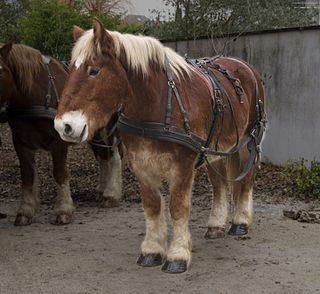
The Trait Breton is a French breed of draught horse. It originated in Brittany, in north-west France, from cross-breeding of local horses with various other breeds. It is strong and muscular, and often has a chestnut coat.

The Trait du Nord, previously also known as Ardennais du Nord or Ardennais de type Nord, is a breed of heavy draft horse developed and bred in the area of Hainaut in western Belgium and in northeastern France. Originally considered a subtype of the Ardennes, it was recognized as an individual breed with the opening of a studbook in 1903. Developed in the fertile Flemish grasslands, it was bred for size and pulling power for agricultural work. By 1855, the horses bred near Hainaut were considered by some veterinarians to be superior to other Flemish draft breeds. The Trait du Nord was used extensively in mining from the late 19th century through 1920, with lesser use continuing through the 1960s.
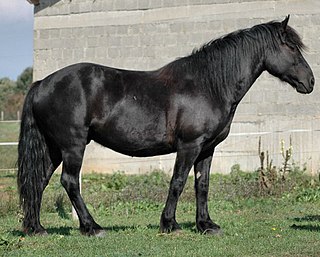
The Mérens, Cheval de Mérens or Caballo de Merens, still occasionally referred to by the older name of Ariégeois pony, is a small, rustic horse native to the Pyrenees and Ariégeois mountains of southern France, where the Ariège River flows, and northern Spain, near Andorra. Two general types, a small, light traditional mountain horse and a taller, sportier modern type, are found. Always black in color, Mérens must meet strict physical standards in order to be registered in the stud book. The breed is known for its sure-footedness on mountain terrain, as well as for its endurance, hardiness and docility. The French breed registry organizes regional offices, and partners with other national organizations in Europe to preserve and promote the breed. The organization enforces rigorous selection of breeding stock, with a goal of increasing quality in the breed. In the past, the Mérens was used for farm work, draft work and as pack horses. Today it is mainly used as a saddle horse, although some members of the breed have been successful in carriage driving. Many Mérens are taken on an annual transhumance, in which they are moved higher in the mountains during the summer and into the valleys for the winter. An old practice, it fell into disfavor, but has recently re-emerged.

The Poitevin or Poitou is a French breed of draft horse. It is named for its area of origin, the former province of Poitou in west-central France, now a part of the region of Nouvelle-Aquitaine. It was formed in the seventeenth century when horses of Flemish or Dutch origin, brought to the area by engineers working to drain the Marais Poitevin, interbred with local horses. Although it has the size and conformation of a draft horse, the Poitevin has never been bred for draft abilities, and has been little used for draft work. Its principal traditional use was the production of mules. Poitevin mares were put to jacks of the large Baudet du Poitou breed of donkey; the resulting Poitevin mules were in demand for agricultural and other work in many parts of the world, including Russia and the United States. In the early twentieth century there were some 50,000 brood mares producing between 18,000 and 20,000 mules per year.

The Baudet du Poitou, also called the Poitevin or Poitou donkey, is a French breed of donkey. It is one of the largest breeds, and jacks were bred to mares of the Poitevin horse breed to produce Poitevin mules, which were formerly in worldwide demand for agricultural and other work. The Baudet has a distinctive coat, which hangs in long, ungroomed locks or cadenettes.

The Thoroughbred is a horse breed best known for its use in horse racing. Although the word thoroughbred is sometimes used to refer to any breed of purebred horse, it technically refers only to the Thoroughbred breed. Thoroughbreds are considered "hot-blooded" horses that are known for their agility, speed, and spirit.

The Auvergne horse is a breed of light draft horse from the Auvergne region of south central France. It stands 143 to 147 centimetres at the withers, and weighs 450–650 kilograms (990–1,430 lb). Coat colours are bay or seal brown. It is used mainly for trekking. It was recognised as a breed by the Haras Nationaux, the French association of horse breeders in December 2012. The standard is published by a breeders' association, the Association Nationale du Cheval de Race Auvergne.

The Norman Cob or Cob Normand is a breed of light draught horse that originated in the region of Normandy in northern France. It is of medium size, with a range of heights and weights, due to selective breeding for a wide range of uses. Its conformation is similar to a robust Thoroughbred, and it more closely resembles a Thoroughbred cross than other French draught breeds. The breed is known for its lively, long-striding trot. Common colours include chestnut, bay and seal brown. There are three general subsets within the breed: horses used under saddle, those used in harness, and those destined for meat production. It is popular for recreational and competitive driving, representing France internationally in the latter, and is also used for several riding disciplines.

The Henson Horse, or Cheval de Henson, is a modern horse breed from northeast France. It was created by the selective breeding of light saddle horses with the smaller, heavier Norwegian Fjord horse to create small horses suitable for the equestrian vacation industry. The breeders' association, Association du Cheval Henson, was formed in 1983. In 1995 the studbook was closed to horses not born from Henson parents, and in 2003 the breed was officially recognised by the French government agencies for horse breeding. A hardy breed of horse, each winter the broodmares and youngstock from several breeders are let loose together to graze freely in the wetland reserves in France.

The Charentais and Vendéen are extinct breeds of horse from western France. They were bred principally in the area around Poitou-Charentes and Vendée, France. They were used as a mount for light cavalry.
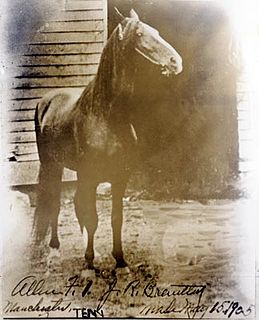
Black Allan or Allan F-1 was the foundation sire of the Tennessee Walking Horse. He was out of a Morgan mare named Maggie Marshall and by Allendorf, a stallion descended from Narragansett Pacer, Canadian Pacer, and Gaited Spanish Mustang imported from Texas. Black Allan was registered as No. 7623 by the American Trotting Registry. Although Black Allan was supposed to be a trotter, he preferred to pace and so never raced. Besides the pace, he performed a lateral ambling gait now known as the running walk. He was a black stallion standing 15 hands, 5 feet high. He was given the designation Allan F-1 when the Tennessee Walking Horse Breeders' Association, precursor to the Tennessee Walking Horse Breeders' and Exhibitors' Association, was formed in 1935. He had multiple owners throughout his life, but his last owners, James Brantley and Albert Dement, were the only ones to recognize Black Allan's use as a breeding stallion. Black Allan sired 111 known foals in his lifetime, among them Roan Allen, registration number F-38, Hunters Allen F-10, and Merry Legs F-4. Black Allan died September 16, 1910, at the age of 29.

The Flemish Horse, Dutch: Vlaams Paard, French: Cheval Flamand, is a Belgian breed of draught horse. It became extinct in the nineteenth century when it was merged with the Brabant to create the Belgian Draught. From about 1993 it was recreated from some stock kept by Amish people in the United States. A breed association, Het Vlaams Paard, was formed in 1999. In 2005 the breed was officially approved by the Flemish government, and the breed association authorised to manage the stud-book.





















